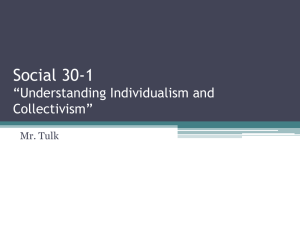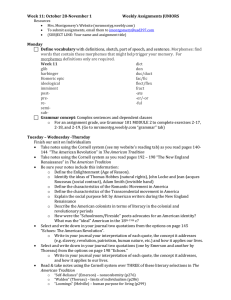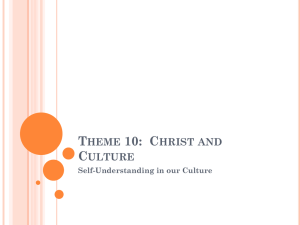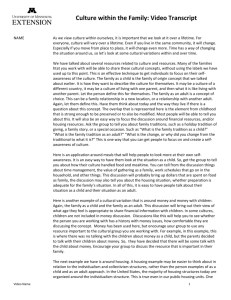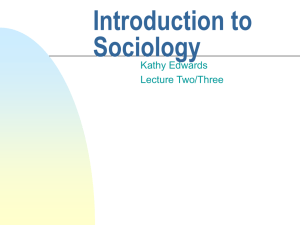Dr. Thomas B. Leininger Page 1 of 2
advertisement
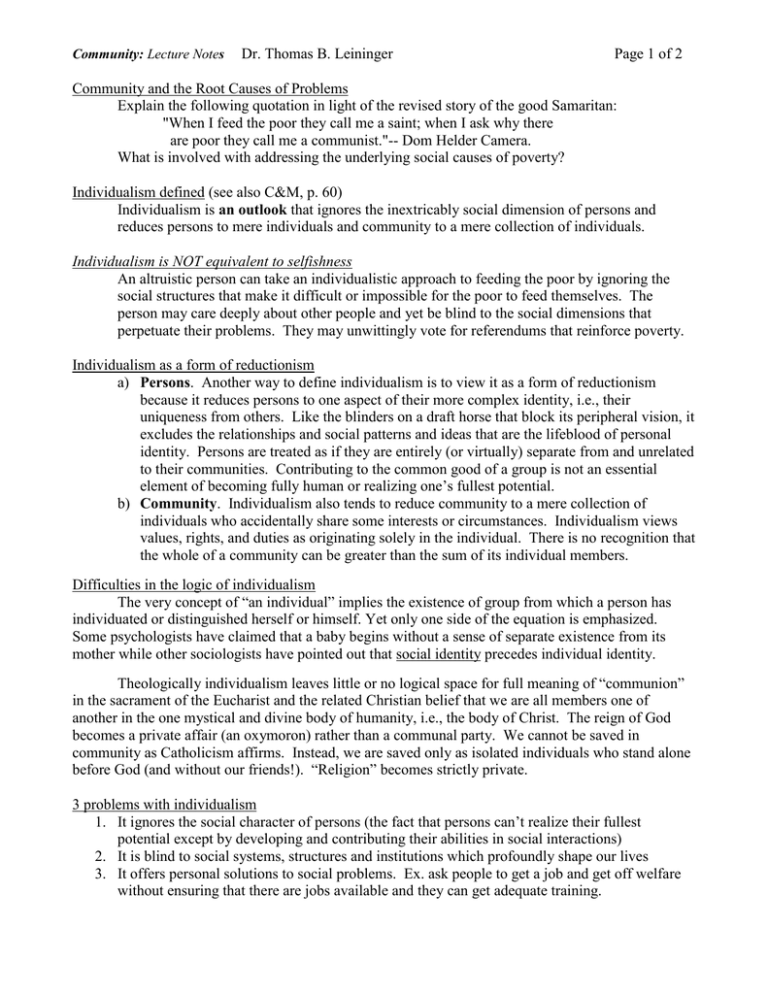
Community: Lecture Notes Dr. Thomas B. Leininger Page 1 of 2 Community and the Root Causes of Problems Explain the following quotation in light of the revised story of the good Samaritan: "When I feed the poor they call me a saint; when I ask why there are poor they call me a communist."-- Dom Helder Camera. What is involved with addressing the underlying social causes of poverty? Individualism defined (see also C&M, p. 60) Individualism is an outlook that ignores the inextricably social dimension of persons and reduces persons to mere individuals and community to a mere collection of individuals. Individualism is NOT equivalent to selfishness An altruistic person can take an individualistic approach to feeding the poor by ignoring the social structures that make it difficult or impossible for the poor to feed themselves. The person may care deeply about other people and yet be blind to the social dimensions that perpetuate their problems. They may unwittingly vote for referendums that reinforce poverty. Individualism as a form of reductionism a) Persons. Another way to define individualism is to view it as a form of reductionism because it reduces persons to one aspect of their more complex identity, i.e., their uniqueness from others. Like the blinders on a draft horse that block its peripheral vision, it excludes the relationships and social patterns and ideas that are the lifeblood of personal identity. Persons are treated as if they are entirely (or virtually) separate from and unrelated to their communities. Contributing to the common good of a group is not an essential element of becoming fully human or realizing one’s fullest potential. b) Community. Individualism also tends to reduce community to a mere collection of individuals who accidentally share some interests or circumstances. Individualism views values, rights, and duties as originating solely in the individual. There is no recognition that the whole of a community can be greater than the sum of its individual members. Difficulties in the logic of individualism The very concept of “an individual” implies the existence of group from which a person has individuated or distinguished herself or himself. Yet only one side of the equation is emphasized. Some psychologists have claimed that a baby begins without a sense of separate existence from its mother while other sociologists have pointed out that social identity precedes individual identity. Theologically individualism leaves little or no logical space for full meaning of “communion” in the sacrament of the Eucharist and the related Christian belief that we are all members one of another in the one mystical and divine body of humanity, i.e., the body of Christ. The reign of God becomes a private affair (an oxymoron) rather than a communal party. We cannot be saved in community as Catholicism affirms. Instead, we are saved only as isolated individuals who stand alone before God (and without our friends!). “Religion” becomes strictly private. 3 problems with individualism 1. It ignores the social character of persons (the fact that persons can’t realize their fullest potential except by developing and contributing their abilities in social interactions) 2. It is blind to social systems, structures and institutions which profoundly shape our lives 3. It offers personal solutions to social problems. Ex. ask people to get a job and get off welfare without ensuring that there are jobs available and they can get adequate training. Community: Lecture Notes Dr. Thomas B. Leininger Page 1 of 2 Individualism vs. Individuality Making a distinction between individuality and individualism can be helpful. If we define individuality as the distinctive identity of an individual understood in the context of his or her common identity with others, then individuality can avoid the extremes of individualism and totalitarianism. While individualism reduces persons to their distinctiveness to the exclusion of their social identity, totalitarianism reduces persons to their sameness to others in society to the exclusion of their distinctiveness. In short, individuality is a healthy part of a good community because it allows all persons to discover, develop, and share their diverse gifts for the good of the whole community. This notion is compatible with the Catholic affirmation of the ultimate harmony of the fullest good of both the individual and the society. The crucial question is not really “Is there too much or too little emphasis on either the individual or the community?”, as much as it is “What kind of individual and communal identity will best allow all members to flourish through participation in the common good?” Institutions, Structures, and Systems These terms name three forms of established patterns of communication, behavior, and thought: 1. Institutions—are established practices, formalized ways of behaving that provide a model for how things are to be done in a group (SMALLEST) Ex. marriage; hand shake. 2. structures—are the organized patterns formed by groups of institutions. They organize or "structure" the interactions between individuals or groups. (MEDIUM) Ex. Family life includes a whole range of institutions such as prayer before meals, allowances, etc. 3. systems—groups of structures that are pulled together into interrelated patterns. (LARGEST) Ex. The military-industrial complex; global capitalism Internalization vs. Externalization Internalization –the process by which an individual take inside herself ideas, attitudes, behaviors, values, beliefs, feelings, etc. from her environment. Ex. Body images presented in the media that are internalized so thoroughly that they lead to eating disorders. NOTE: Socialization is essentially the process of internalization viewed from the perspective of society as the actor. Ex. The media socializes young teens to accept a few body images as the model for all attractive bodies. Externalization—the process by which internal ideas, attitudes, values, etc. are given concrete form and reality outside of oneself (in one’s environment) and, eventually, may become social practices and customs. Ex. A group of college students forms a sorority or a fraternity. Questions to consider 1) How do the five traits of a just society on pp. 69-70 address the problems of individualism? 2) Where does King speak about individualism? 3) How do the revised good Samaritan, MLK, and Wink’s Jesus address the problems of individualism and illustrate C&M’s claim on p. 70 that building a just community is a twopronged process involving both personal and social (structural) change? 4) How do these materials illustrate the claims about character in the lectures and in ch. 3 of C&M? 5) How do materials in the reader (including the rabbits from Watership Down) illustrate the key concepts from ch. 4 in C&M?
